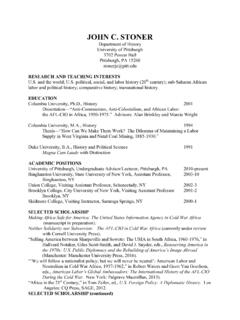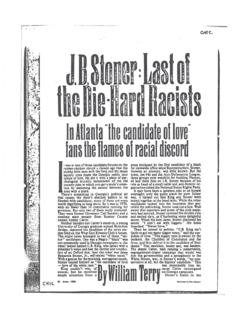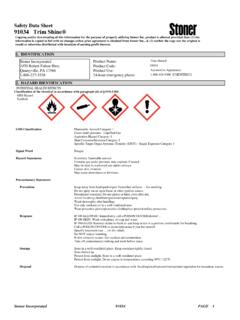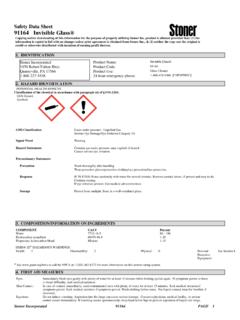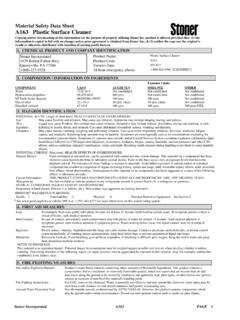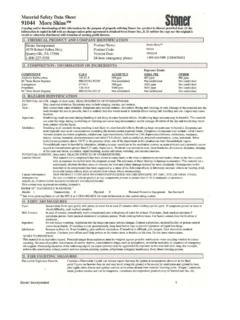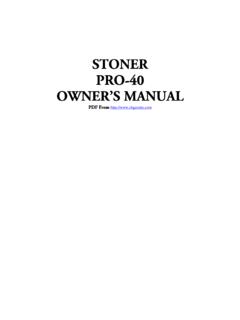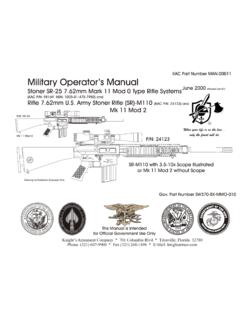Transcription of PRELIMINARY OPERATOR'S AND ORGANIZATIONAL …
1 ']'. J " . THIS PUBLICATION DOES NOT CONTAIN CLASSIFIED INFORMATION. PRELIMINARY OPERATOR'S . AND ORGANIZATIONAL . maintenance MANUAL. LIGHT MACHINEGUN, BELT FED: STONER 63A. MANUFACTURED BY. CADILLAC GAGE COMPANY. Small Arms Division Warren, Michigan ~~~{>;' DE KRUITHOORN ' OG.!"W 'JSCH - HOLLAND. THIS PUBLICATION IS NOT AVAILABLE THROUGH. ADJUTANT GENERAL PUBLICATIONS CHANNELS. Table of Contents Paragraphs Page CHAPTER 1. INTRODUCTION. Section I. General .. II. Description and data.. 2 2. CHAPTER 2. OPERATING INSTRUCTIONS. Section I. Service upon receipt of materiel.}
2 5 5. II. Controls .. 7 6. III. Operation under usual .. 10 9. CHAPTER 3. ORGANIZATIONAL maintenance INSTRUCTIONS. Section I. Repair parts, tools, and equipment .. 22 13. II. Lubrication .. 25 14. III. Preventive- maintenance services .. 28 16. IV. Troubleshooting .. 30 18. CHAPTER 4. maintenance OF MACHINE GUN .. 32 21. APPENDIX I. REFERENCES.. 35. APPENDIX II. BASIC ISSUE ITEMS 36. APPENDIX III. ORGANIZATIONAL maintenance . REPAIR PARTS, AND SPECIAL. TOOL 40. a CHAPTER 1. INTRODUCTION. Section I. GENERAL. 1. SCOPE. a. This manual contains instructions for operator and ORGANIZATIONAL maintenance of the Stoner light machinegun, belt-fed.
3 Appendix I contains a list of current references and publications applicable to this materiel. Q. Appendix II contains a list of basic issue items, repair parts, and tools and equipment which are required for operational maintenance of the weapon.. Appendix III contains a list of repair parts, special tools and equipment which are required for performing ORGANIZATIONAL maintenance of the weapon. Section II. DESCRIPTION AND DATA. 2. DESCRIPTION.. lc The Stoner light machinegun (belt-fed) is a 5 .56mm automatic weapon (figure 1) The ammunition is fed into the weapon by means of a disintegrating metallic link belt.
4 The weapon fires from the open-bolt position and features a quick-change barrel. The operational energy is provided by the gas from the fired round. b. Sights are adjustable in l/4 mil increments in windage and elevation and are graduated on a scale from 200 to 1100 meters. The fully-adjustable front sight can be zeroed to the rear sight in both windage and elevation. 3. NAME AND SERIAL NUMBER. The name and serial number of the weapon are stamped on the bottom of the receiver in front of the trigger housing (figure 14) . FIGURE 1. STONER LIGHT MACHINEGUN. BELT- FED LEFT AND RIGHT VIEW.
5 2. 4 . TABULATED DATA. a. Weight (in pounds) . Light Machinegun, belt-fed lbs. Full plastic ammunition box (100 rounds) 3. 31 lbs. Sling 0. 31 lbs. Firing Weight (100 rounds, sling and bipod) 1bs. Bayonet knife, M7 0. 60 lbs. Scabbard, MBA! Bipod 0. 88 lbs. Bipod case 0. 31 1bs. b. Lengths (in inches) . Light Machinegun, belt-fed in. Light Machinegun, belt-fed, with bayonet Barrel (bolt face to muzzle) in. Barrel with Extension & Flash Suppressor in. c. Mechanical Features Rifling Right Hand Twist (6 grooves), one turn in 12 in. Bore diameter (maximum) .220 in.
6 Groove diameter (maximum) .2245 in. Sight Radius in. (from rear of rear sight aperture to mid- point of front sight). Trigger Pull Maximum 9 1bs. Minimum 6 lbs. Method of Operation Gas Type of Lock Mechanism Rotating bolt Method of Feeding Belt feed, disin- tegrating metallic link Cooling Air d. Ammunition Caliber 5 .56mm (. 223 caliber). Type Ball, tracer and blank. 3. e. Firing Characteristics . Muzzle Velocity 3250 fps _ 40 fps Muzzle Energy 1300 ft. lbs. (approx). Chamber Pressure 50,000 . 2000 psi Cyclic Rate of Fire Variable from 700. to 100 0 rds. per min.
7 Maximum Sustained Rate of Fire 75- 125 rds. per min. Maximum Effective Rate of Fire 150-200 rds. per min. Maximum Range 2895 yds. (2653 meters). Maximum Effective Range 1203 yds (llOO meters). 4. CHAPTER 2. OPERATING INSTRUCTIONS. Section I. SERVICE UPON RECEIPT OF MATERIEL. 5. GENERAL..!:! When a weapon is received, it is the responsibility of the officer in charge to determine whether the materiel has been properly prepared for service by the supplying organization and to be sure it is in condition to perform its function .. All repair parts, tools, and equipment will be checked with the lis t!
8 Ng in Appendix II and III .. A record will be made of all missing parts, tools, and equipment and of any malfunctions. Deficiencies will be corrected as quickly as possible. 6. SERVICES. When preparing weapons that are packed with volatile-corrosion inhibitor <vcn, the following procedures shall be followed: .!:! Weapon (1} Unpacking, Open container and remove the weapon and equipment. Remove VCI wrapping from all surfaces. Clean per paragraph (2) below and assemble. (2) Cleaning. Wipe off excess oil with a clean dry cloth. Run a clean dry patch through the bore of the weapon before firing.)
9 (3) Lubrication. Lubricate as indicated in paragraphs 25. through 27. (4) Inspection. Perform inspection as indicated in paragraph 34 .. Bipod. For service pertaining to the bipod refer to paragraph 36. 5. Section II. CONTROLS. 7. GENERAL. This section describes, locates, and illustrates the various controls provided for the operation and ORGANIZATIONAL maintenance of the weapon. 8. WEAPON CONTROLS. Barrel Latch. The barrel latch (figure 2) is located on the top of the weapon to the front of the feed cover. It consists of three parts, latch, lockpin and spring assembly.
10 Attached to the rear of the latch is the locking pin which locks and holds the barrel into position. ]:)_. Cocking Handle. The cocking handle (figure 2) is located on the right side of the receiver. This control allows for manual cocking of the weapon when required. The cocking handle spring (figure 19) locks the handle in its forward position ..9. Safety. The safety is located just forward of the trigger (figure 2) . When pushed all the way forward through the slot in the trigger guard, the safety is in the "OFF" or "FIRE'' position. When pulled all the way to the rear, towards the trigger, it is in the "SAFE" position.
